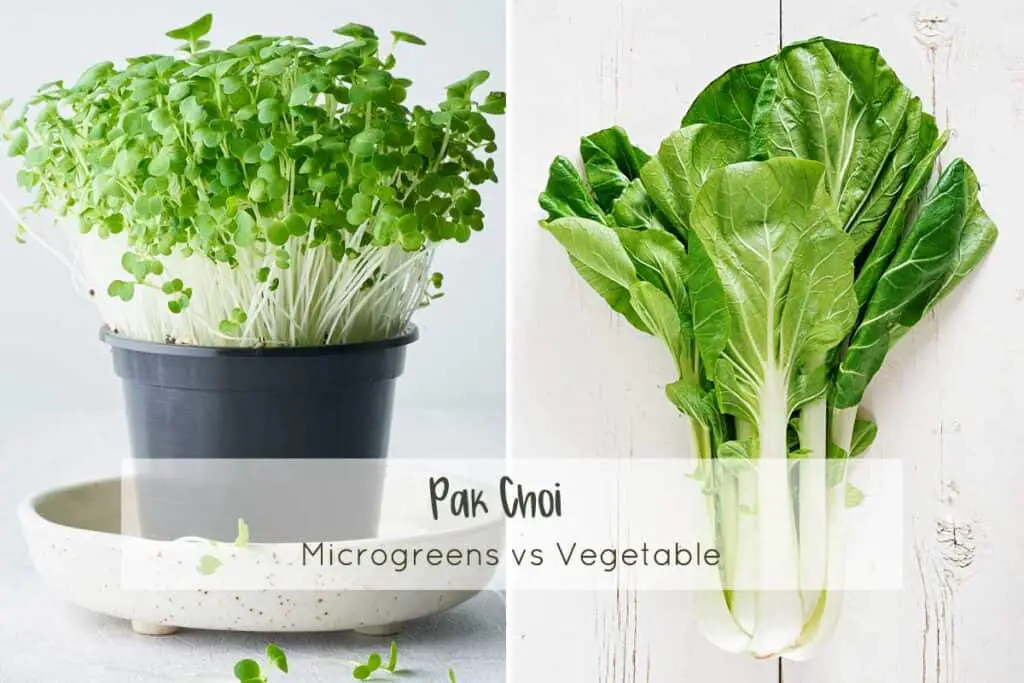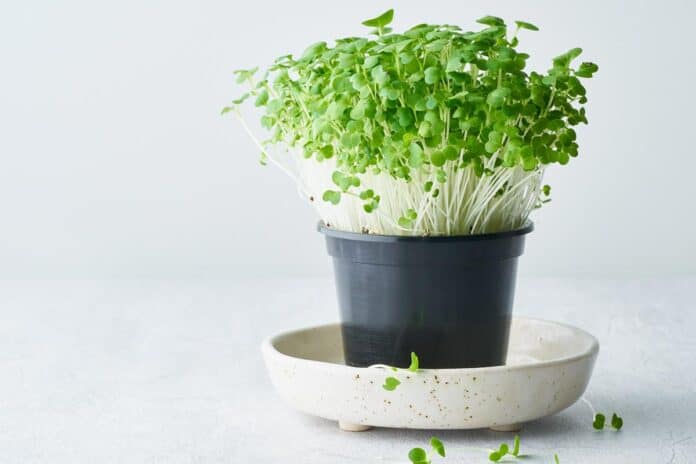If you are a fan of Asian Cuisine, then this microgreen is for you! Pak Choi is a fast-growing microgreen that you can harvest and enjoy in just ten days! This sweet and mild tiny green is full of goodness and lovely taste. You can use it with your curry or simply as add a garnish to any meal!
What are Pak Choi Microgreens?
Pak Choi microgreens are the mini version of the popular vegetable commonly used in Asian dishes. This beautiful microgreen has white stems and green leaves, similar to the full-grown veggie. And it has a unique flavor; mild but at the same time a bit nutty, and a little bit sweet.
As microgreens, they are easy to manage, and you can plant and harvest in less than two weeks, which makes them ideal for beginners.
| Growing period | 10-12 days |
| Flavor | Mild and sweet flavor |
| Growing difficulty | Easy |
| Buy seeds | Pak Choi seeds from True Leaf Market |
Description
Pak Choi is a member of the cabbage family, and it has its origin in China. You may have heard of it as Bok Choi, Pak Choir, or Choi Sum. Well, all of them are the same plant! It’s also referred to as the Chinese cabbage.
The full-grown vegetable has a white and thick stem (shaped like a bulb) and green leave blades (similar to celery-like stalks). All parts of the Pak Choi are edible, the same as the microgreen.

If you are a fan of Chinese and other Asian food, you have most likely enjoyed the Pak Choi. It’s commonly used in stir-fries and spring rolls. In Western cuisine, we see it often steamed, blanched, or even just fried on the pan.
What is great about Pak Choi, apart from its taste and how easy it is to cook, is that it’s a highly nutritious vegetable that is available all year round!
General Nutrition & Benefits
Pak Choi microgreens are highly nutritious. They have a high concentration of vitamins (A, C, E & K) and minerals, but at the same time low in calories.
Along with it being a tasty and crunchy green, it also full of fibers and antioxidants! Overall, it’s a vegetable that provides valuable nutrients and is well-suited to a healthful diet.
READ ALSO: The Most Nutritious Microgreens to Grow and Eat
How to grow Pak Choi Microgreens
Pak Choi is a fast-growing microgreen and easy to manage. It makes them ideal for beginners growing at home.
| Growing timeline (eatimated) | |
|---|---|
| Presoak | No |
| Preferred medium | Hydroponic, soil, or coconut coir |
| Avg. seed weight (10/20 tray) | 1 oz (20 grams) |
| Germination period (blackout) | Day 1-4 |
| Growth time (sunlight) | Day 4-9 |
| Harvest | Day 10-12 |
To grow Pak Choi microgreens at home, you need a few materials to get you started:
- Seeds
- A container/tray (preferable a shallow one)
- Water spray bottle
- Growing medium
You can grow them in potting soil, coconut coir, or using a hydroponic mat. Either way will work well.
When growing microgreens, it’s beneficial to use a container with drainage holes and a bottom tray with none. You then place the top one in the bottom one, and it catches any excess water.
Find the container of your choice and fill it up with your growing medium. Always flatten it out to make an even surface. It will help you when you sprinkle the seeds, and you will get a uniform distribution.
Some seed types benefit from being soaked in advance, but with Pak Choi, you can skip this step. You don’t have to presoak the seeds, but you plant them directly.
Once you have planted the seeds, place the container in the dark to support the germination (this is referred to as the Blackout period). When you deprive the seeds of light, you help them germinate as you are mimicking the same process as if the seeds were planted and dug down in the soil.
You can use a piece of aluminum foil, another tray, a towel, or similar to cover your container for around three days. Once the seeds have developed into about an inch to an inch and half long stems, you know they are ready to be exposed to the light.
Place your tray in a window sill where there is enough light coming through (minimum of 6 hours a day) or under a grow light. Leave the microgreens for another five days until they have reached their mature stage. It’s when they have grown bright white stems and have developed their first true leaves. Pak Choi leaves are small with rounded corners.
During both the blackout period and sunlight period, you should gently water your microgreens twice a day; once in the morning and once in the evening. It’s important that you keep the soil moist, but never soaked.
Overwatering is one of the most common mistakes and what causes crops to grow mold. So always keep an eye on your container to ensure that you give the right amount of water and good airflow.
Learn more about How To Control Humidity and Temperature in Microgreens
Culinary Guiding
Pak Choi microgreens are great to use in Asian dishes, as it has the same taste like the mature veggie. Add them on top of a curry, or mix in any souped noodle dish! As they are so beautiful with their white stems, they are also great to use as garnish.
RELATED: Tasty Ways To Use Microgreens
Another great way to use the microgreen is to mix in a slaw!
Here is some other great inspiration:
- Stir-fry a full-grown bok choy and mix with other steamed vegetables, add some soy sauce and sesame oil, sprinkle the microgreens, and make a tasty a salad
- Chop the microgreens up and add to hot and sour Asian soup
Enjoy!



